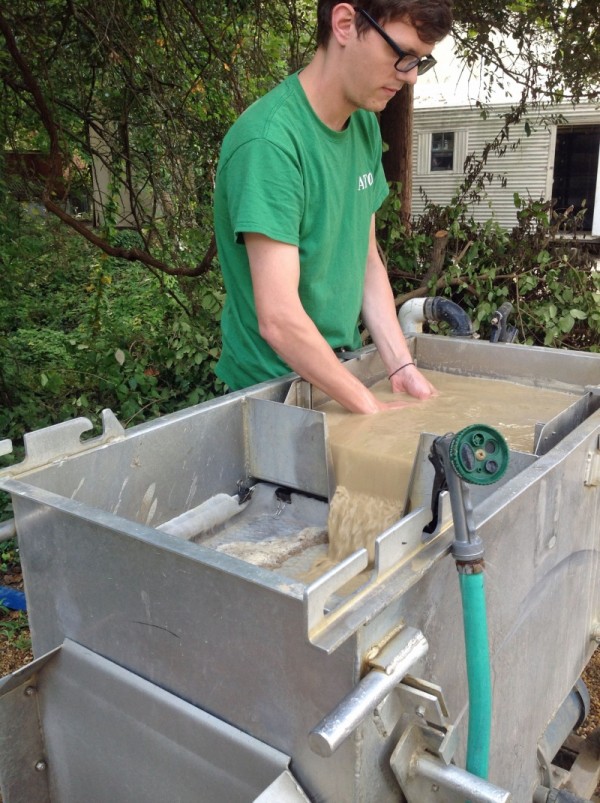The Wren Yard Site (Photo credit: Willie Grahan)
Monday marked an important day in our archaeological calendar.
On Friday, final samples were collected from the Wren Yard Site, and on Monday morning Colonial Williamsburg’s archaeologists arrived at their offices, cleanly attired and ready to begin a new “season” of work. Archaeologists are sometimes mistakenly accused of having active and inactive times of the year. The active is presumably identified by deepening excavation trenches and rising backdirt piles, while the inactive is recognized by our conspicuous absence from the field. We are, indeed, absent from the field, but as summer turns to fall we find ourselves “differently active.”
“What is it?” is a question that we heard daily while excavating a foundation in the shadow of the College of William and Mary’s Wren Building. Sometimes the answer is obvious. This time we are not as certain. We have speculated that we may have found a brewhouse, mentioned in early College documents as one of the first amenities constructed for its students. Over the next few months we will work as a team to test all of the data we have collected…artifacts, soil samples, maps, drawings, and photographs… against this, and other, hypotheses.
Volunteer Kathy Ballentine washes one of the nearly 500 bags of artifacts from the Wren Yard dig.
Just what, precisely, will we be looking at?
At last count, 481 bags of artifacts (and some very large stones) are packed on shelves in the lab’s washroom waiting to be cleaned, identified, and cataloged. After prioritizing (early and important contexts will be washed before artifacts from topsoil or utility trenches), staff and volunteers will spend several months at the sink, and even longer at a computer screen. From those efforts will come a clearer date for the building’s construction, demolition and a plausible narrative for the activities that took place in, and around, it.

The flotation tank allows archaeologists to recover the smallest bits of evidence. Here, Ben processes a bag of soil from the summer’s work.
In the lab’s parking lot, the “flotation tank” is almost always running. Bags of soil taken from the site’s most promising features are dumped into the tank where circulating water encourages the very lightest materials: charred seeds, fish scales, and small mammal bones, to rise to the surface. These materials are skimmed off and picked through for information that might have been missed in our ¼” mesh screens. Plant materials are of special interest on this project. The recovery of grains used in brewing could help to support the brewhouse theory, but unexpected evidence may surface instead!
For the field staff, this season brings an opportunity to take a more comprehensive look at the summer’s findings. What sort of a building matches the odd configuration of what we uncovered? What do we know about the College’s early construction? How was beer brewed in the 18th century? These questions will take us to published materials, to other archaeological site reports, and to experts in a variety of subjects, from architecture to yeast analysis.
Lucie transforming individual images into a brick-by-brick drawing of the Wren Yard foundation.
Dozens individual drawings and maps are being digitized to create an overall site map. These computerized maps allow us to separate site features belonging to the same time period so that we can view the site’s development. In the image above Lucie is using photographs, anchored in space with the total station, to make a brick-by-brick CAD drawing of the Wren Yard foundation.
Finally, a large handful of special studies are gearing up: analysis of the site’s oyster shells and animal bones, as well as a study of the unusual ceramic vessels that were recovered. More on these in the months to come!
I am very excited to see the floatation tank being used. Once archaeology was “bones and pots”, but now with more scientific disciplines - geology and botany leap to mind - as part of the “team” we can get such a fuller, richer view of the past. The advances in computers allow the creation of a three-dimensional visual representation of the site, which I think will lead us to more discoveries. As I understand the work of Dr. Stanley South, his question was not just “What is it?”, but “How did this get here?”. He wanted to reveal the temporal, spatial, and cultural relationships among the artifacts he found, just as you are on this project. I anticipate the next blog entry with relish!